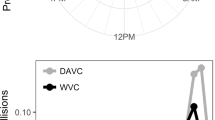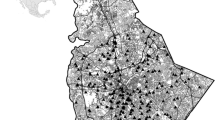Abstract
The Pantanal of Brazil, the world’s largest freshwater wetland, supports a large diversity of species and is under continually increasing pressure from human development, including vehicle collisions with wild animals. We examined decadal, annual, and spatial variation in wildlife-vehicle collisions along highway BR-262 in the southern Pantanal, and specifically: (1) what is the rate of roadkill along BR-262, and did it increased over the previous decade, (2) which species are frequently victims of collisions and does this vary annually along the highway’s length, and (3) what anthropogenic or environmental factors may influence this variation and how can the context of collisions inform mitigation? We sampled the highway monthly, between April 2011 and June 2012, stopping when roadkill was observed to identify species and collect GPS coordinates and a photographic record. Data was analyzed temporally and in relation to traffic volume and precipitation, and imported into a GIS and analyzed spatially and in relation to elevation. We recorded 518 carcasses from 40 species over the 15 sampling periods. The rate of roadkill incidents was 1 every 6.2 km, a tenfold increase since 2002, and is now one of the highest in Brazil. IUCN Red List species were observed, including lowland tapir, giant anteater, and marsh deer. At the lowest elevations, during seasonal wetland inundation the causeway embankment is sought for refuge, increasing collision probability. Mitigation measures tied to seasonal flood pulse variation along the causeway may reduce the high rate of wild animal mortality and loss of biodiversity.




Similar content being viewed by others
References
Alho CJR (2005) The Pantanal. In: Fraser LH, Keddy PA (eds) The world’s largest wetlands—ecology and conservation. Cambridge University Press, New York, pp 203–271
Alho CJR, Silva JSV (2012) Effects of severe floods and droughts on wildlife of the Pantanal wetland (Brazil)—a review. Animals 2:591–610
Alho CJR, Camargo G, Fisher E (2011) Terrestrial and aquatic mammals of the Pantanal. Braz J Biol 71:297–310
Aresco MJ (2003) Highway mortality of turtles and other herpetofauna at Lake Jackson, Florida, USA and the efficacy of a temporary fence/culvert system to reduce road kills. In: Irwin CL, Garrett P, McDermott KP (eds) 2003 Proceedings of the international conference on ecology and transportation. Center for Transportation and the Environment, North Carolina State University, Raleigh, pp 433–449
Bagatini T (2006) Evolução dos índices de atropelamento de vertebrados silvestres nas rodovias do entorno da Estação ecológica de Águas Emendadas, DF, Brasil, e eficácia de medidads mitigatórias. Master’s thesis, Universidade de Brasilia
Bandeira C, Floriano EP (2004) Avaliação de impacto ambiental de rodovias. Caderno Didático, Santa Rosa, p 69
Biondo C, Keuroghlian A, Gongora J, Miyaki CY (2011) Population genetic structure and dispersal in white-lipped peccaries (Tayassu pecari) from the Brazilian Pantanal. J Mammology 92:267–274
Campos Z, Magnusson W (1995) Relationship between rainfall, nesting habitat and fecundity of Caiman crocodilus yacare in the Pantanal, Brazil. J Trop Ecol 11:351–358
Catella AC, Thomas WM, Mourão GM (2010) BR-262 no Pantanal: cenário de encontros entre homens e animais silvestres. Embrapa Pantanal, Corumbá
CNT (Confederação Nacional do Transporte) (2006) Atlas do Transporte, 1st edn. http://www.sistemacnt.org.br/informacoes/pesquisas/atlas/2006/index.htm. Accessed 24 May 2012
Conover MR, Pitt WC, Kessler KK, DuBow TJ, Sanborn WA (1995) Review of human injuries, illnesses, and economic losses caused by wildlife in the United States. Wildl Soc Bull 23:407–414
Courtenay O, Maffei L (2008) Cerdocyon thous. In: IUCN 2013. IUCN red list of threatened species. Version 2013.2. http://www.iucnredlist.org. Accessed 27 Apr 2014
Coutinho M, Campos Z (1996) Effect of habitat and seasonality on the densities of caiman in Southern Pantanal, Brazil. J Trop Ecol 12:741–747
Coutinho ME, Campos ZMS, de Mourão G, Mauro RA (1997) Aspectos ecológicos dos vertebrados terrestres e semi aquáticos no Pantanal. Plano de Conservação da Bacia do Alto Paraguai (Pantanal)—PCBAP: diagnóstico dos meios físicos e bióticos: meio biótico. Ministério do Meio Ambiente, dos Recursos Hídricos e da Amazônia Legal, Brasília, pp 183–322
Desbiez A, Donatti CI, Marques RM, Keuroghlian A, Tomas WM, Galetti M, Santos SA, Bodmer RE (2004) Uso de Habitat e Densidades Populacionais de Queixadas, Catetos e Porcos-Monteiros em duas Áreas do Pantanal Brasileiro. VI Congresso Internacional sobre Manejo de Fauna Silvestre en la Amazonia y Latinoamerica, Iquitos
Dique DS, Thompson J, Preece HJ, Penfold GC, Villiers DL, Leslie RS (2003) Koala mortality on roads in south-east Queensland: the koala speed-zone trial. Wildl Res 30:419–426
ESRI (2011) ArcGIS desktop: release 10. Environmental Systems Research Institute, Redlands
Evink GL, Garret P, Zeigler D, Berry J (1996) Trends in addressing transportation related wildlife mortality. Publication no. FL-ER-58-96. Florida Department of Transportation, Tallahassee
Fischer WA (1997) Efeitos da rodovia BR-262 na mortalidade de vertebrados silvestres: Síntese naturalística para a conservação da região do Pantanal. Master’s thesis, Universidade Federal de Mato Grosso do Sul
Fischer WA (1999) Programa Estrada Viva—Volumes 1 e 2: Impactos da BR-262 sobre a Vida Selvagem e Proposta de Intervenção. Technical report, GEIPOT Conv. Min.Tranportes/UFMS, Brasília
Fischer WA, Ramos-Neto MB, Silveira L, Jácomo ATA (2004) Human transportation network as ecological barrier for wildlife on Brazilian Pantanal-Cerrado corridors. In: Irwin CL, Garrett P, McDermott KP (eds) Proceedings of the 2003 international conference on ecology and transportation. Center for Transportation and the Environment, North Carolina State University, Raleigh, pp 182–194
Forman RTT (1995) Land mosaics: the ecology of landscapes and regions. Cambridge University Press, Cambridge
Forman RTT, Alexander LE (1998) Roads and their major ecological effects. Annu Rev Ecol Syst 29:207–231
Forman RTT, Friedman DS, Fitzhenry D, Martin JD, Chen AS, Alexander LE (1997) Ecological effects of roads: toward three summary indices and an overview for North America. In: Canters K (ed) Habitat fragmentation and infrastructure—proceedings. Ministry of Transport, Public Works & Water Management, Delft, pp 40–54
Forman RTT, Sperling D, Bissonette JA, Clevenger AP, Cutshall CD, Dale VH, Fahrig L, France R, Goldman CR, Heanue K, Jones JA, Swanson FJ, Turrentine T, Winter TC (2003) Road ecology: science and solutions. Island Press, Washington
Foster ML, Humphrey SR (1995) Use of highway underpasses by Florida panthers and other wildlife. Wildl Soc Bull 23:95–100
Freitas CH (2009) Atropelamento de vertebrados nas rodovias MG- 428 e SP-334 com análises de fatores condicionantes e valorização econômica da fauna. Ph.D. Dissertation, Instituto de Biociências, Universidade Estadual Paulista “Júlio Mesquita Filho”
Glista DJ, DeVault TL, DeWoody JA (2008) Vertebrate road mortality predominantly impacts Amphibians. Herpetol Conserv Biol 3:77–87
Glista DJ, DeVault TL, DeWoody JA (2009) A review of mitigation measures for reducing wildlife mortality on roadway. Landsc Urban Plan 91:1–7
Harris MB, Arcangelo C, Pinto ECT, Camargo G, Ramos-Neto MB, Silva SM (2005) Estimativas de perda da área natural da Bacia do Alto Paraguai e Pantanal Brasileiro. Relatório técnico não publicado. Conservação Internacional, Campo Grande
Hobday AJ, Minstrell ML (2008) Distribution and abundance of roadkill on Tasmanian highways: human management options. Wildl Res 35:712–726
IBM Corp (2010) IBM SPSS statistics for windows. Version 19.0. IBM Corp, Armonk
IUCN (2013) The IUCN red list of threatened species. Version 2013.2. http://www.iucnredlist.org. Accessed 27 Apr 2014
Jones ME (2000) Road upgrade, road mortality and remedial measures: impacts on the population of eastern quolls and Tasmanian devils. Wildl Res 27:289–296
Junk WJ, da Silva CJ (2000) O conceito de inundação e suas implicações para o Pantanal de Mato Grosso. In: Anais do II Simpósio sobre Recursos Naturais e Sócio-econômicos do Pantanal. Manejo e Conservação. EMBRAPA, Corumbá
Keuroghlian A, Desbiez A, Reyna-Hurtado R, Altrichter M, Beck H, Taber A, Fragoso JMV (2013) Tayassu pecari. In: IUCN 2013. IUCN red list of threatened species. Version 2013.2. http://www.iucnredlist.org. Accessed 27 Apr 2014
Lalo J (1987) The problem of roadkill. Am For 50:50–52
Maehr DS, Land ED, Roelke ME (1991) Mortality patterns of Panthers in southwest Florida. Proceedings of the annual conference of the southeastern association of fish and wildlife agencies, vol 45., pp 201–207
Martinelli MM, Volpi TA (2011) Mamíferos atropelados na Rodovia Armando Martinelli (ES-080), Espírito Santo, Brasil. Espírito Santo. V. Natureza on line 9:113–116
Medici EP, Desbiez ALJ (2012) Population viability analysis: using a modeling tool to assess the viability of tapir populations in fragmented landscapes. Integr Zool 7:356–372
Miranda F, Meritt DA Jr. (2011) Tamandua tetradactyla. In: IUCN 2013. IUCN red list of threatened species. Version 2013.2. http://www.iucnredlist.org. Accessed 27 Apr 2014
Miranda F, Medri I (2010) Myrmecophaga tridactyla. In: IUCN 2012 IUCN red list of threatened species. Version 2012.2. www.iucnredlist.org. Accessed 5 June 2013
MMA (Ministério do Meio Ambiente) (2007) Cerrado and Pantanal: priority areas and actions for biodiversity conservation. Biodiversity Series 17, Ministério do Meio Ambiente, Brasília
Mourão GM, Coutinho M, Mauro R, Campos Z, Tomas WM, Magnusson WE (2000) Aerial surveys of caiman, marsh deer and pampas deer in the Pantanal wetland of Brazil. Biol Conserv 92:175–183
Naveda A, de Thoisy B, Richard-Hansen C, Torres DA, Salas L, Wallance R, Chalukian S, de Bustos S (2008) Tapirus terrestris. In: IUCN 2013. IUCN red list of threatened species. Version 2013.2. http://www.iucnredlist.org. Accessed 27 Apr 2014
Nunes AP (2011) Quantas espécies de aves ocorrem no Pantanal brasileiro? Atualidades Ornitológicas On-line 160:45–54
Potts A, Potts V (2004) Features and conservation of the Brazilian Pantanal wetland. Wetl Ecol Manage 12:547–552
Prada CS (2004) Atropelamento de vertebrados silvestres em uma região fragmentada do nordeste do Estado de São Paulo: quantificação do impacto e análise de fatores envolvidos. Ph.D. Dissertaiton, Centro de Ciências Biológicas e da Saúde, Universidade Federal de São Carlos, São Carlos
Prado TR, Ferreira AA, Sobrinha Guimarães ZF (2006) Efeito da implantação de rodovias no cerrado sobre a fauna de vertebrados. Acta Sci Biol Sci 18:237–241
Rocha EHD (2005) Impactos dos transportes rodoviários na fauna. Master’s thesis, Universidade Federal do Rio de Janeiro, Rio de Janeiro
Rodrigues FHG, Medri IM, Thomas VM, Mourão GM (2002) Revisão do conhecimento sobre ocorrência e distribuição de mamíferos do Pantanal. Embrapa Pantanal, Corumbá
Romin LA, Bissonette JA (1996) Deer-vehicle collisions: status of statemonitoring activities and mitigation efforts. Wildl Soc Bull 24:276–283
Rosa AO, Mauhs J (2004) Atropelamentos de animais silvestres na Rodovia RS-040. Caderno de Pesquisa Série Biologia 16:35–42
Sampaio RS, Brito PCR (2009) Impactos ambientais causados pela construção de rodovias. Master’s thesis, Universidade Católica do Salvador, Salvador
Schafer JA, Penland ST (1985) Effectiveness of Swareflex reflectors in reducing deer–vehicle accidents. J Wildl Manage 49:774–776
SEOP (Secretaria de Estado de Obras Públicas e de Transportes) (2012) Mapa do tráfego total mensal, praça de pedágio, Porto Morrinho
Souza JC, Lima JAF (2012) O Pantanal de Forma Sustentável. In: Julio César de Souza (ed) Pantanal Produzindo com Sustentabilidade. Universidade Federal de Mato Grosso do Sul, Campo Grande, pp 7–18
Tonin AM, Amaral BTC, Paier C, de Oliveira CH. (2009) Impactos a fauna silvestre por atropelamento nas rodovias da região norte do Rio Grande do Sul, Brasil. In: Congresso de ecologia do Brasil, 9. São Lourenço
Trolle M, Noss AJ, Cordeiro JLP, Oliveira LFB (2008) Brazilian tapir density in the Pantanal: a comparison of systematic camera-trapping and line-transect surveys. Biotropica 40:211–217
Trombulak SC, Frissell CA (2000) Review of ecological effects of roads on terrestrial and aquatic communities. Conserv Biol 14:18–30
WWF—Brasil (2012) Sustentabilidade: a teoria a prática. http://www.wwf.org.br/. Accessed 6 Jan 2012
Acknowledgments
Dr. de Souza would like to thank the Fundação CAPES, Ministério da Educação do Brasil, Brasilia/DF, and Universidade Federal de Mato Grosso do Sul for support of this research, as well as Andrea G. Dos Santos, Carolina F. de Souza, Geovane G. Ramires, Israel Cardoso, Jenifer Azambuja, Marcos P. G. Rezende, Sandriane S. Batista, Vanessa T. Gonçalves for assistance with field sampling. The authors would also like to thank two anonymous reviewers for their insightful recommendations.
Funding Sources
Funding for the research described in the submitted manuscript was provided to Julio de Souza by the following sources: Fundação CAPES, Ministério da Educação do Brasil, Brasilia/DF Universidade Federal de Mato Grosso do Sul.
Author information
Authors and Affiliations
Corresponding author
Rights and permissions
About this article
Cite this article
de Souza, J.C., da Cunha, V.P. & Markwith, S.H. Spatiotemporal variation in human-wildlife conflicts along highway BR-262 in the Brazilian Pantanal. Wetlands Ecol Manage 23, 227–239 (2015). https://doi.org/10.1007/s11273-014-9372-4
Received:
Accepted:
Published:
Issue Date:
DOI: https://doi.org/10.1007/s11273-014-9372-4




